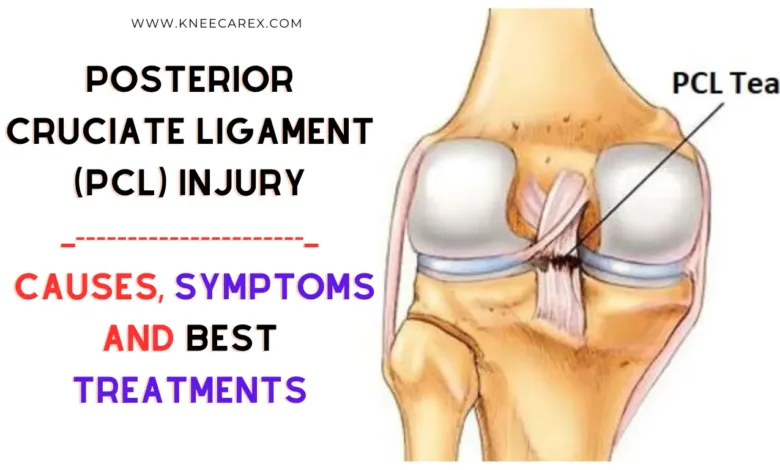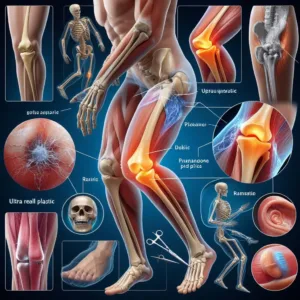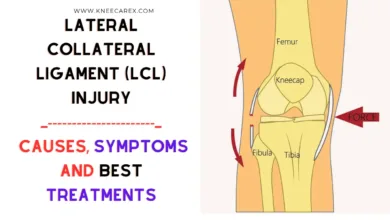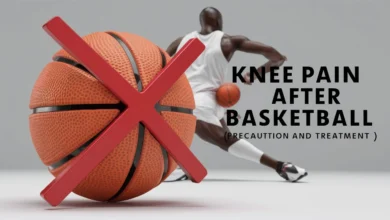Posterior Cruciate Ligament (PCL) Injury: Causes, Symptoms and Treatments

The posterior cruciate ligament (PCL) injury may not be as well-known as its front-facing counterpart, the ACL, but when it comes to knee injuries, it plays a crucial role. A PCL injury can be a game-changer, affecting not only athletes but also anyone who relies on their knees for daily movement. Whether you’re an avid sports enthusiast or simply navigating through the challenges of daily life, understanding the causes, symptoms, and treatments of PCL injuries is paramount for maintaining optimal knee health.
Contents
- 1 Understanding the Posterior Cruciate Ligament (PCL)
- 2 Anatomy of the Knee: Emphasizing the PCL
- 3 Common Causes of PCL Injuries
- 4 Recognizing Symptoms of a PCL Injury
- 5 Different Diagnostic Methods for PCL Injuries
- 6 Current Treatment Options for PCL Injuries
- 7 Rehabilitation and Recovery from PCL Injuries
- 8 FAQ’s
- 8.1 How long does it take for a PCL injury to heal?
- 8.2 Can you still walk with a torn PCL?
- 8.3 How serious is a PCL injury?
- 8.4 Can a PCL tear heal on its own?
- 8.5 How do you tell if the PCL is torn or sprained?
- 8.6 Can you walk with a torn PCL?
- 8.7 Can a posterior cruciate ligament heal itself?
- 8.8 How long does a PCL strain take to heal?
- 8.9 How do you test for a posterior cruciate ligament?
- 8.10 What tests are used for a PCL?
- 8.11 What is a positive PCL test?
- 8.12 How do I check my PCL?
- 9 Conclusion: Posterior Cruciate Ligament (PCL) Injury
Understanding the Posterior Cruciate Ligament (PCL)

Understanding the unique biomechanics of PCL injuries is essential for accurate diagnosis and effective treatment. Unlike ACL tears, which are frequently seen in athletes, PCL injuries may present with more subtle symptoms but can still significantly impact daily activities and quality of life. Recognizing these differences can aid healthcare professionals in providing tailored care for individuals with PCL injuries, whether through conservative rehabilitation or surgical intervention. By shedding light on this lesser-known ligament, we can increase awareness about its importance in knee function and ensure comprehensive management for those experiencing PCL-related issues.
Anatomy of the Knee: Emphasizing the PCL
The posterior cruciate ligament (PCL) plays a crucial role in stabilizing the knee joint by preventing excessive backward movement of the tibia bone. Despite being less commonly injured than the anterior cruciate ligament (ACL), PCL injuries can have a significant impact on knee function. The unique anatomy and function of the PCL make it an important structure to understand when discussing knee injuries.
The PCL is located within the knee joint, connecting the femur to the tibia, and is essential for controlling the posterior translation of these bones during knee movement. While often overshadowed by the ACL, understanding the specific biomechanics and role of the PCL allows healthcare professionals to better diagnose and treat injuries. Its complex relationship with other structures in the knee highlights its importance in maintaining stability and function. Understanding this intricate network can improve treatment approaches for individuals dealing with PCL injuries, leading to better outcomes and recovery.
Common Causes of PCL Injuries

In addition, another common cause of PCL injuries is non-contact trauma, typically seen in sports like soccer and basketball where sudden changes in direction or awkward landings may put excessive stress on the posterior cruciate ligament. It’s important for athletes and individuals alike to be mindful of these potential causes and take preventative measures to reduce their risk of sustaining a PCL injury.
Recognizing Symptoms of a PCL Injury
Recognizing the symptoms of a PCL injury can be crucial to seeking timely medical attention. Unlike the more common ACL injuries, PCL injuries may initially present with less obvious symptoms, leading to a potential underestimation of their severity. One key indicator is pain and swelling behind the knee, often accompanied by instability and difficulty bearing weight on the affected leg. Furthermore, individuals might notice a popping sensation at the time of injury or struggle with full range of motion during activities that involve bending the knee.
Navigating Golf Knee Injuries: Prevention, Symptoms, and Recovery
An often overlooked aspect of recognizing PCL injury symptoms is understanding the impact on daily activities. Patients may find it challenging to engage in physical tasks such as climbing stairs or standing for prolonged periods due to discomfort and instability. Additionally, persistent stiffness and weakness in the knee joint are common indications that should not be dismissed lightly. By being attuned to these nuanced symptoms, individuals can proactively seek appropriate medical attention and initiate targeted rehabilitation for optimal recovery from a PCL injury.
Different Diagnostic Methods for PCL Injuries

Best Radiologists for x-rays and ultrasounds near You
Another diagnostic method gaining traction is ultrasound imaging, particularly in instances where an MRI might not be readily accessible or feasible. Ultrasound can provide real-time images and dynamic assessments, allowing for a more immediate evaluation in certain clinical settings. Furthermore, arthroscopy, a minimally invasive surgical procedure involving a small camera inserted into the knee joint, can not only confirm PCL injuries but also allow for concurrent treatment during the same procedure. These varied diagnostic methods offer healthcare providers multiple avenues to accurately assess PCL injuries and tailor appropriate treatment plans for each patient’s unique circumstances.
Current Treatment Options for PCL Injuries
One of the most promising treatments for PCL injuries is platelet-rich plasma (PRP) therapy, which involves injecting a concentrated form of the patient’s own blood into the injured area. This can help stimulate the body’s natural healing process and promote faster recovery. Additionally, some studies have shown that PRP therapy can improve knee stability and function in patients with PCL injuries.
Another exciting development in PCL injury treatment is the use of regenerative medicine techniques such as stem cell therapy. This innovative approach aims to harness the body’s own healing mechanisms by introducing new, healthy cells to repair damaged tissue. While research on stem cell therapy for PCL injuries is still ongoing, initial findings are promising and suggest that it may offer significant benefits in promoting tissue repair and reducing inflammation. As these cutting-edge treatments continue to evolve, they hold great potential for revolutionizing the management of PCL injuries and providing more effective and long-lasting solutions for patients.
Rehabilitation and Recovery from PCL Injuries

As rehabilitation progresses, functional activities like squats, lunges, and balance exercises are integrated to improve proprioception and fine-tune muscular coordination. A crucial aspect of PCL recovery is regaining proper biomechanics during activities of daily living as well as sports-specific movements. The incorporation of neuromuscular training can enhance dynamic stability during cutting, pivoting, and jumping motions which are essential for athletes returning to high-level competition. Overall, a tailored rehabilitation program supervised by experienced professionals is pivotal in achieving optimal outcomes following a PCL injury.
Volleyball Knee Pain: 7 Breakthrough Strategies for a Winning Comeback!
FAQ’s
How long does it take for a PCL injury to heal?
Recovering from a PCL injury can be a frustrating and time-consuming process, as the healing timeline varies greatly depending on the severity of the injury. Contrary to popular belief, PCL injuries generally take longer to heal compared to other ligament injuries due to their limited blood supply and complex structure. While mild cases may see significant improvement within 3-6 weeks with conservative treatment, more severe injuries often require several months of dedicated rehabilitation. It’s crucial for patients to understand that rushing the recovery process can lead to long-term complications, such as chronic instability or early-onset arthritis in the knee joint.
Can you still walk with a torn PCL?
A torn posterior cruciate ligament (PCL) can significantly affect a person’s ability to walk, as it stabilizes the knee. While some can walk with a torn PCL, it’s crucial to seek medical attention for diagnosis and treatment. Walking with a torn PCL can worsen the injury and lead to further damage. Instability can increase the risk of falls or other injuries. Seeking professional guidance from orthopedic specialists or physical therapists is essential for developing a treatment plan that may include bracing, rehabilitation exercises, or surgery.
How serious is a PCL injury?
A PCL injury is a serious medical condition that can have long-term implications if not properly treated. Unlike the more commonly known ACL injury, a PCL injury often goes undiagnosed and untreated, leading to chronic knee instability and potential arthritis in the long run. Many people underestimate the severity of PCL injuries due to their less frequent occurrence in comparison to ACL injuries, but they can significantly impact an individual’s mobility and quality of life.
Can a PCL tear heal on its own?
While some minor PCL tears can heal on their own with rest and rehabilitation, more severe tears often require medical intervention. The posterior cruciate ligament has a limited ability to heal due to its poor blood supply, which can prolong the recovery process. However, with proper care and treatment, the body’s natural healing processes can help repair the PCL over time. This may involve a combination of physical therapy, bracing, and activity modification to allow for optimal healing.
How do you tell if the PCL is torn or sprained?
When determining whether the PCL is torn or sprained, the extent of the injury plays a key role in diagnosis. While both injuries can result from a sudden traumatic event or direct impact, a torn PCL often leads to more severe symptoms such as instability and significant swelling in the knee joint. On the other hand, a sprained PCL may cause less severe pain and swelling but still result in discomfort and reduced mobility. The difference lies in the degree of damage to the ligament, with a tear indicating more substantial disruption to its structure and function.
Can you walk with a torn PCL?
Walking with a torn posterior cruciate ligament (PCL) can be painful and potentially cause long-term complications like arthritis and chronic knee pain. It’s crucial to seek medical attention and allow the ligament to heal properly through conservative treatments or surgical intervention. Rehabilitation exercises and physical therapy can help restore strength and function to the knee joint. Continuing to walk with a torn PCL can have serious consequences for long-term knee health.
Can a posterior cruciate ligament heal itself?
While some minor PCL injuries may heal on their own with rest and rehabilitation, more severe injuries often require medical intervention. Unlike the Anterior cruciate ligament (ACL), the PCL has a better capacity for natural healing due to its thicker and stronger structure. However, complete healing without any residual instability is rare, especially in cases of significant trauma or complete tears. In such instances, conservative treatments like physical therapy can help strengthen surrounding muscles to compensate for the injured ligament, but surgical options may be necessary to fully restore stability and function to the knee joint.
How long does a PCL strain take to heal?
PCL strains can take weeks to heal, with severe injuries requiring months of rest and rehabilitation. Factors like injury severity, age, health, and treatment adherence influence the healing process. Rushing recovery can lead to long-term complications and re-injury. Conventional treatments like RICE can manage symptoms, but professional medical advice is crucial. Targeted exercises and patience are essential for a successful outcome.
How do you test for a posterior cruciate ligament?
Testing for a posterior cruciate ligament (PCL) injury involves a combination of physical examination and imaging techniques. One of the most common tests is the posterior drawer test, where the physician applies gentle pressure to the tibia in a backward direction while the knee is bent at 90 degrees. This test assesses the amount of posterior translation of the tibia relative to the femur, which can indicate PCL instability. Additionally, specialized imaging techniques such as MRI or arthroscopy may be employed to visualize and confirm PCL injuries, offering valuable insights into the extent and severity of the damage.
What tests are used for a PCL?
When it comes to diagnosing a PCL injury, several tests are used to assess the severity and stability of the ligament. One common test is the posterior drawer test, where the physician will manipulate the knee joint to check for abnormal movement of the tibia in relation to the femur. Another key assessment is the dial test, which involves rotating the tibia externally while measuring any increased rotation compared to the uninjured knee. Additionally, imaging tests such as MRI or X-rays may be utilized to visualize any damage or displacement of the PCL.
Best Radiologists for x-rays and ultrasounds near You
What is a positive PCL test?
A positive PCL test refers to a physical examination maneuver used to assess the integrity of the posterior cruciate ligament in the knee. During this test, a healthcare professional applies specific force or pressure to the lower leg to assess the degree of posterior sag and translation in comparison to the uninjured side. A positive result indicates excessive posterior sag or translation, suggesting a potential PCL injury or instability in the knee joint.
How do I check my PCL?
When it comes to checking your PCL for a potential injury, there are several key methods you can utilize. One of the most common and effective ways is to perform a physical examination, which typically involves assessing the stability and range of motion in your knee joint. Doctors may also employ imaging techniques such as MRI or X-rays to get a more detailed view of the PCL and surrounding structures. These diagnostic tools can provide essential information about the extent of any potential damage.
Conclusion: Posterior Cruciate Ligament (PCL) Injury
In conclusion, preventing PCL injuries requires a proactive approach that addresses both intrinsic and extrinsic risk factors. Maintaining proper muscle balance and strength through targeted exercises can help stabilize the knee joint and reduce the likelihood of PCL injury. Additionally, implementing biomechanical assessments for athletes can help identify movement patterns or imbalances that may increase the risk of PCL injury, allowing for targeted intervention to correct these issues early on.





One Comment